Comptroller Kevin Lembo Archive > News
COMPTROLLER LEMBO PROJECTS $43.4-MILLION SURPLUS FOR FISCAL YEAR 2014This latest surplus projection is a $461.5-million decline from last month, following a newly revised consensus revenue forecast released by the Office of Policy and Management (OPM) and the non-partisan Office of Fiscal Analysis (OFA).
In a letter to Gov. Dannel P. Malloy, Lembo concurred that income tax revenue experienced a significant decline in April from last month's forecast, by approximately $389.1 million. The income tax decline explains most of the erosion in the surplus, though other revenue revisions are responsible for the remaining $72.4-million decline.
"These final income tax payments buck historical trends - but reinforce my position that economic volatility and uncertainty demand sustained financial caution, discipline and rebuilding our Budget Reserve Fund," Lembo said. "I am pleased to hear that any surplus will be directed to the Budget Reserve Fund.
"Over the past 10 fiscal years, estimated income tax payments and final income tax payments trended in the same direction in all but one fiscal year," Lembo said. "If estimated payments trended higher, final payments followed a similar upward trend. The only deviation from this pattern was in Fiscal Year 2010 when a new income tax bracket was added. This fiscal year, final income tax payments deviated significantly from the historical pattern utilized in the last projections and created the significant income tax shortfall."
The double-digit decline was likely due to investor decision-making in response to a 2012 change in the federal capital gains tax rate that has impacted multiple states this year, Lembo said.
"This change shifted future year gains-taking by taxpayers into Fiscal Year
2013 in order to take advantage of the lower federal tax rate structure," Lembo
said. "In the absence of this federal change, some of the prior year gains would
likely have been realized this fiscal year."
Lembo said the entire General Fund surplus adjustment this month is attributable to revenue changes, as spending has remained unchanged this month and is still below budget targets.
"Leading up to this decline in revenue projection and reduced surplus, I have emphasized that the state faces new financial challenges in the outlying years," Lembo said. "At the risk of repetition, it is critically important that we directly deposit any additional surplus in excess of this month's estimate into the Budget Reserve Fund to account for future unanticipated shortfalls."
The reserve balance at the end of Fiscal Year 2013 was $270.7 million. This
represents 1.6 percent of net appropriations.
"I have advocated for a reserve level of 15 percent of spending," Lembo said. "Sufficient dollars in reserve will guard against future tax increases and service reductions during inevitable future recessionary cycles.
"Despite the decline in General Fund surplus, there are some bright spots in Connecticut's overall economy," Lembo said, pointing to a strengthening housing market and other indicators.
Lembo highlighted data and other information from federal and state Departments of Labor and other sources that show:

- Year-to-date gains in the employment-driven withholding portion of the state income tax remained positive through March growing 2.3 percent from a year ago. For the cumulative three-month period ending in March, withholding collections were up 2.5 percent, largely due to strong receipts posted in February.
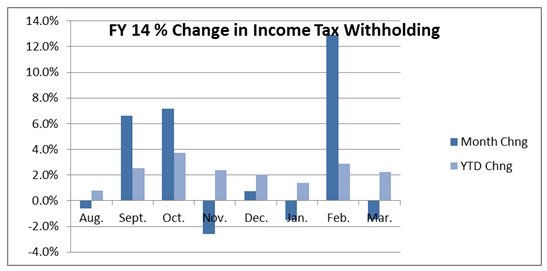
- Connecticut gained 4,900 payroll jobs in March. Over the 12 months ending in March, the state had added 9,400 jobs. According to the Department of Labor, Connecticut regained 65,000 payroll positions, or 54.6 percent of the 119,100 positions lost to the March 2008 - February 2010 employment recession. Nationally, all of the jobs lost to the recession had been recovered by March 2014.
- The table below shows the distribution of employment gains and losses by super sector over the latest 12-month period.
| Job Gains Latest 12 Months | Job Losses Latest 12 Months | ||
|---|---|---|---|
| Sector | Sector | ||
| Leisure & Hospitality | 5,500 | Government | -4,100 |
| Education & Health | 5,400 | Manufacturing | -2,300 |
| Transp. & Utilities | 3,100 | Financial Activities | -800 |
| Construction | 2,800 | Information | -500 |
| Prof. & Business Services | 600 | Other Services | -300 |
- Connecticut's unemployment rate was 7.0 percent in March; the national unemployment rate was 6.7 percent that month.
- The charts below are a time series view of Connecticut employment and the unemployment rate.
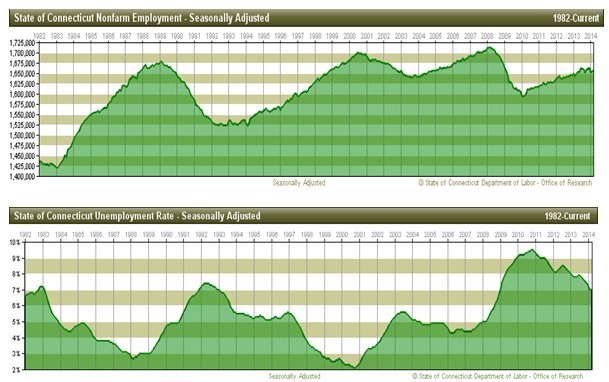
![]()
- Based on data released by the Bureau of Economic Analysis on March 25, personal income in Connecticut grew at a rate of 2.1 percent between 2012 and 2013 ranking the state 37th nationally in personal income growth. Net earnings increased 1.4 percent while dividends, interest and rent increased 3.7 percent. Personal income results for the 1st quarter of 2014 will be released on June 24.
- The chart below shows the annual trend in Connecticut personal income. Because
the state spending cap is based on the growth in personal income (or the rate of
inflation if higher), the current trend places downward pressure on budgeted
state spending. The cap does not apply to debt financed spending.
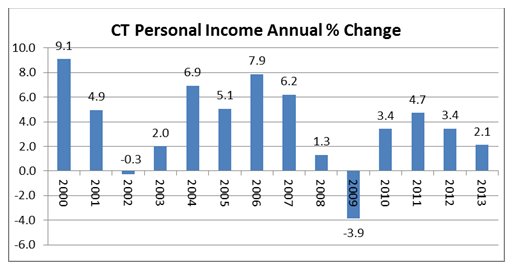
- Average private sector weekly pay was calculated at $942.82 in March, up $12.89, or 1.4 percent over the year.
- The year-to-year change in the Consumer Price Index for All Urban Consumers
(CPI-U, U.S. City Average, not seasonally adjusted) in March 2014 was 1.5
percent.

- A strong housing market has lifted Connecticut's real estate conveyance tax receipts. Through March, total receipts are running more than three-quarters above last year's level.
- Single-family home sales in Connecticut rose 2.8 percent in February according to an April 10 report from The Warren Group. This is the tenth consecutive month of home sale gains in the state. The 2.8-percent increase is below the 6-percent growth rate posted for the full 2013 calendar year, but weather played a role in slowing sales. In addition, February is historically the slowest month of the year for home closings; July has the strongest closing activity. Analysts are expecting pent up demand to accelerate spring sales.
- The median price of single-family homes rose by 4.4 percent in February, selling at $235,000 compared with $225,000 in the same month last year.
- Condominium sales in February accelerated at a brisk rate of 17.2 percent from the same month last year. This is consistent with the strong double-digit growth in 2013. The median price for a condo rose in February by 10.8 percent to $155,000 compared with $139,841 in February 2013.
- According to the National Association of Realtors, total U.S. existing home sales in March were 7.5 percent blow March of 2013. The median price of a home rose 7.9 percent to $198,500 from March of last year. Regionally, existing home sales in the Northeast fell 4.8 percent from last March and prices were up 3.2 percent to $244,700.
![]()
- At this writing the Dow Jones Industrial Average has posted a 12-month gain of 12.75 percent; however, on a calendar year-to-date basis the market has declined slightly.
- The capital gains driven estimated payment portion of the income tax grew by almost 18 percent last fiscal year. This large increase was partially attributable to a capital gains tax change that went into effect at the end of 2012 and resulted in a roll-forward of taxable gains to Fiscal Year 2013. Absent the tax change, these roll-forward gains would have been realized in future years.
- The budget plan anticipated a softening of estimated payments in Fiscal Year 2014 based on the roll-forward activity. However, estimated payments through March of this fiscal year were up by almost 5 percent. The positive trend in estimated payments fueled expectations of growth in April final income tax payments.
- Typically, estimated and final income tax payments have moved in similar
directions. Over the last ten years the only deviation in trend between
estimated and final payments was in Fiscal Year 2010 when an additional income
tax bracket was added.
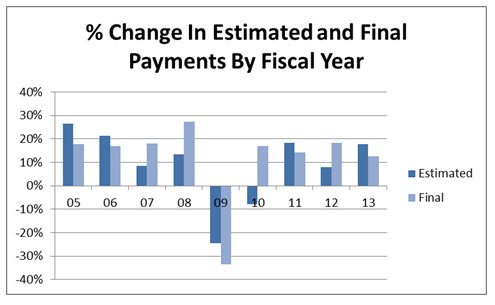
- It now appears that final income tax payments have again run counter to the established trend. The April final income tax payments have trended negative, resulting in a large decline in expected income tax receipts. The income tax loss from last month's estimate is $389.1 million.
- It is difficult at this point in time to accurately determine the cause of the deviation in final income tax payments from the historical trend. Certainly the forward shift in capital gains discussed above played a role. It is also significant that profit taking has been on a downward trend since the height of the financial crisis as trading volume has receded even as the market has risen.
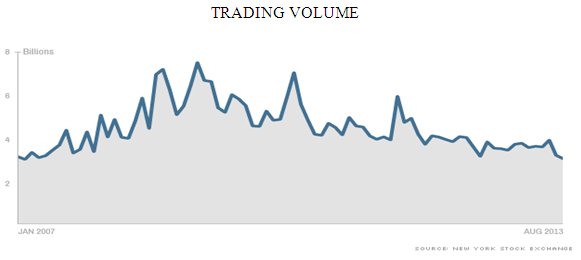
DOW
- At this writing the Dow Jones Industrial Average has posted a 12-month gain of 11.6 percent; however, on a calendar year-to-date basis the market has declined slightly.


Consumers
- Through March the sales tax receipts were accelerating, advancing at a rate of over 9 percent on a fiscal year-to-date basis. Receipts have been improving in the second half of the fiscal year.
- March advance retail sales were up 3.8 percent from the same month last year. This is a significant improvement over February's gain. In calendar year 2013, sales were 4.2 percent higher than in 2012.
- According to the Federal Reserve, in February annualized consumer credit card debt contracted sharply. After growing 1.3 percent in 2013, revolving credit declined at an annualized rate of 3.5 percent in February. Non-revolving credit was up sharply increasing at an annualized 10 percent in February. This resulted in total consumer credit in February advancing by 6.5 percent. Total credit grew 6 percent in 2013.
Business and Economic Growth
- Based on the April 30 release by the Bureau of Economic Analysis, real GDP increased at a rate of 0.1 percent in the 1st quarter of 2014. In the 4th quarter of 2013 real GDP advanced 2.6 percent.
- The deceleration in real GDP growth in the first quarter primarily reflected downturns in exports and in nonresidential fixed investment, a larger decrease in private inventory investment, a deceleration in personal consumption expenditures, and a downturn in state and local government spending that were partly offset by an upturn in federal government spending and a downturn in imports.
- Corporate profits posted growth of 6 percent from one year ago in the 4th quarter of 2013. Profits grew by better than 7 percent in both 2011 and 2012. Profit gains softened in 2013 growing by 4.6 percent.
- The Department of Labor's General Drift Indicators are composite measures of
the four-quarter change in three coincident (Connecticut Manufacturing
Production Index, nonfarm employment, and real personal income) and four leading
(housing permits, manufacturing average weekly hours, Hartford help-wanted
advertising, and initial unemployment claims) economic variables, and are
indexed so 1986 = 100.

